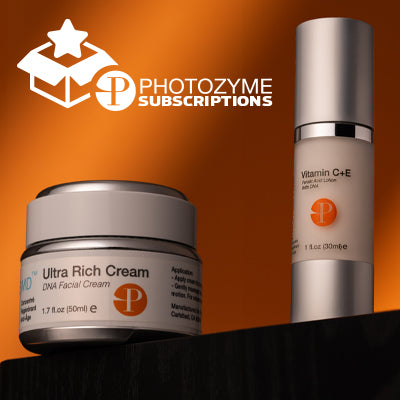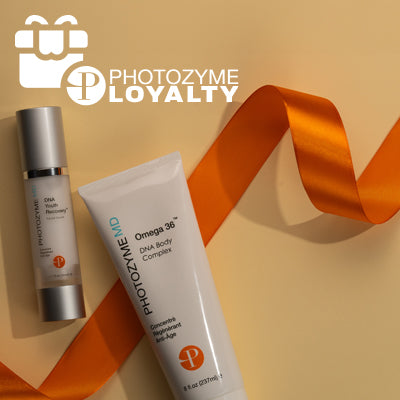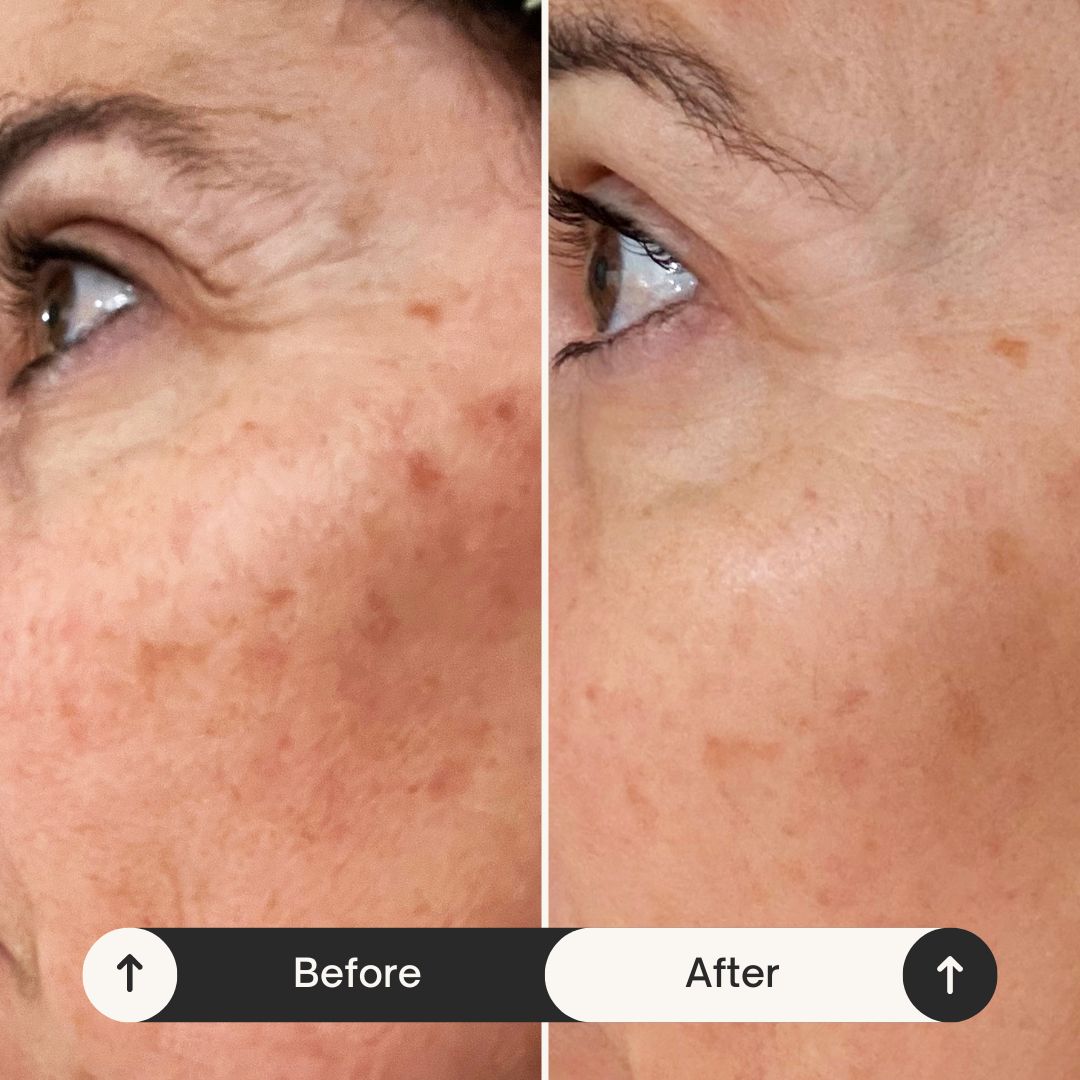This store requires javascript to be enabled for some features to work correctly.
Tranexamic Acid For Skin
Hyperpigmentation, uneven tone, and inflammation often challenge the most consistent skin care routines. Tranexamic acid for skin offers a focused approach to addressing these concerns, especially in sensitive or stubborn cases where other actives fall short. This advanced ingredient is gaining attention in clinical circles because it can calm discoloration and strengthen the skin’s protective barrier. Curious about its mechanism and how it compares to traditional brighteners?
Brighten X - Non Hydroquinone
What is it:
A unique combination of 10 brightening ingredients including 6% tranexamic acid, kojic acid, arbutin, licorice root and vitamin C helps even skin tone and fade dark spots for more luminous-looking skin. Best results when used in combination with PhotozymeMD GFS Plus Night Serum.
How it’s different:
Powered by moxymousse which enables us to combine multiple brightening ingredients like tranexamic acid, kojic acid, niacinamide, arbutin and licorice root to name a few and keep them pure and effective. Because of our unique oxygen and light free manufacturing process, it is formulated to deliver highly effective ingredients gently to the skin to maximize results and minimize irritation. The formula has been clinically proven to deliver visible results.
Benefits
Why you’ll love it:
Helps reduce the appearance of darks spots and pigmentation
Brightens the appearance of skin and improves skin radiance
Helps even the appearance of skin tone
Visibly reduces the appearance of fine lines and wrinkles
Ingredients
Ingredients:
Purified Water, 1,3 Propanediol, Tranexamic Acid, Niacinamide PC, Whitonyl, Alpha Arbutin, Isononyl Isononoate, Achromaxyl IS, C12-15 Alkyl Ethylhexanoate, Ceteth-20, Ceylon Alcohol, Glyceryl Stearate, PEG-75 Stearate, Stearate-20, Dimethicone, Moringa Oil, Cetostearyl Alcohol, 1-Methylhydantoine-2-imide, Kojic Acid, Dermostatyl IS, Tetrahexyldecyl Ascorbate, Phenoxyethanol and Chlorphenesin, Magnesium Aluminum Silicate, BHT, Potassium Sorbate, Sodium Benzoate, Citric Acid, anhyd, USP, Sodium Bisulfite, Xantham Gum, Edetate Disodium, USP, Allantoin, Tocopheryl Acetate, Fresh and Clean Frag, Viapure 97% Licorice White
Directions
How To Use It:
For AM or PM use. If using as a PM treatment, apply following Photozyme GFS Night Serum. If using as an AM treatment, apply after cleansing and follow with SPF for daytime use.
Shipping
Free shipping on US orders over $50
Is Tranexamic Acid Safe For All Skin Types?
Despite the buzz surrounding tranexamic acid in the skincare world, safety remains paramount, especially when addressing diverse skin types.
Broad Tolerance Across Skin Profiles
Tranexamic acid is generally considered well-tolerated and suitable for most skin tones, including sensitive, oily, dry, and combination skin. Unlike some harsher acids, it works without disrupting the skin barrier or causing the peeling and irritation often associated with aggressive treatments.
Ideal For Sensitive And Reactive Skin
Integrating new ingredients can raise concerns for individuals with sensitive or reactive skin. However, clinical studies and dermatological experience highlight tranexamic acid’s gentle profile. Rarely does it trigger stinging or redness, making it a thoughtful option even for those prone to rosacea or post-inflammatory hyperpigmentation.
Non-Exfoliating And Barrier-Safe
One key reason for its widespread acceptance is its non-exfoliating action. Tranexamic acid targets pigment production and inflammation rather than physically sloughing off skin cells, allowing for efficacy without the risk of over-exfoliation. When used as directed, it fits seamlessly into both minimalist and multi-step regimens.
Best Practices For Safe Use
Of course, as with any active ingredient, patch testing remains best practice, particularly for those with compromised or ultra-sensitive skin. Combining tranexamic acid with other gentle, science-backed ingredients further reduces the chances of irritation, supporting its adaptability across skin types and concerns.

The Benefits Of Tranexamic Acid In Skincare
Tranexamic acid, developed initially as a medication to reduce bleeding, has emerged as a groundbreaking ingredient in skincare for its impressive ability to address discoloration and uneven skin tone.
Targeted Treatment For Hyperpigmentation And Melasma
Unlike traditional skin brighteners, tranexamic acid targets the skin’s pigmentation pathways on a cellular level, interrupting the signals that trigger melanin production. This makes it particularly effective for tackling conditions like melasma, sun spots, and post-inflammatory hyperpigmentation.
Clinically Validated Results For Stubborn Discoloration
If you struggle with hyperpigmentation, tranexamic acid may be particularly effective. Clinical studies support its ability to reduce the appearance of stubborn dark spots, melasma, and post-inflammatory discoloration by targeting the pathways that trigger excess pigment production. This precision means you can enjoy a more even skin tone without the irritation often associated with other brightening agents.
Barrier Support And Moisture Retention
But the benefits don’t stop at pigmentation. Tranexamic acid is also known to strengthen the skin’s natural barrier, helping to retain moisture and improve resilience against environmental stressors. This dual action of fighting discoloration while reinforcing your skin’s defense translates to a complexion that looks clearer, healthier, and more youthful.
Formulation Compatibility And Routine Integration
Incorporating tranexamic acid into your skincare routine can blend well with other potent actives, including retinol and vitamin C. Its gentle nature allows it to be layered seamlessly, enhancing the effects of your regimen without increasing sensitivity. So, whether you’re managing photodamage, age spots, or uneven texture, tranexamic acid represents an innovative approach to supporting your skin’s long-term health.
Reveal brighter, more balanced skin with Photozyme’s clinically formulated solutions. Our tranexamic acid treatments target stubborn discoloration, support barrier function, and even tone, without irritation. Trusted by professionals and backed by science, it’s skincare that works smarter. Make every step of your routine count with precision-based care for long-term skin clarity. Shop now at Photozyme.
Combining Tranexamic Acid With Other Skincare Ingredients
Tranexamic acid skincare is most effective when thoughtfully integrated with other advanced ingredients. This synergistic approach targets a broader range of skin concerns while maximizing visible results.
Enhancing Brightening With Niacinamide
Pairing tranexamic acid with niacinamide creates a powerful combination for those seeking a more even complexion. Niacinamide regulates sebum, reduces inflammation, and reinforces the skin barrier, which not only improves tolerance of active ingredients but also aids in calming redness associated with pigmentation disorders. When used together, tranexamic acid disrupts melanin production at the cellular level, while niacinamide works upstream to prevent new discoloration from forming. The result is visibly brighter, more stable skin with fewer flare-ups, especially for those comparing niacinamide vs. vitamin C for tone correction.
Antioxidant Synergy With Vitamin C
Vitamin C is a clinically respected antioxidant that protects the skin from oxidative stress caused by UV exposure and environmental pollutants. It also plays a critical role in collagen synthesis and skin tone improvement. When combined with tranexamic acid, the two ingredients complement each other: Tranexamic acid reduces melanin production, while vitamin C neutralizes free radicals that can trigger pigment formation. This pairing is particularly effective for addressing dullness, photodamage, and uneven tone, making it ideal for morning use under sunscreen or makeup. It also pairs well with other antioxidants when layering retinol and vitamin C in a thoughtfully spaced routine.
Recovery And Pigment Control With DNA Repair Enzymes
Combining tranexamic acid with DNA repair enzymes or signal peptides is especially beneficial for skin recovering from professional treatments or ongoing inflammation. DNA enzymes help identify and repair oxidative damage at a cellular level, accelerating skin renewal and restoring function. Tranexamic acid, in this context, suppresses the inflammatory triggers of hyperpigmentation. They provide a non-irritating, reparative environment, making this combination suitable for post-procedure care, melasma-prone skin, or users managing long-term skin sensitivity.
Hydration Support From Hyaluronic Acid
Maintaining hydration is essential for maximizing active ingredient performance and minimizing irritation. Hyaluronic acid, a moisture-binding molecule naturally found in the skin, complements tranexamic acid by improving skin elasticity and increasing product absorption. Well-hydrated skin responds better to pigmentation correction and is less likely to show signs of flaking or tightness. This pairing is instrumental in evening routines, where overnight recovery is prioritized, and can benefit all skin types, especially those prone to dehydration.
Integrating Into A Science-Driven Routine
For optimal results, tranexamic acid should be integrated into a carefully structured skincare routine that accounts for compatibility and ingredient sequence. Start using it in a serum form, layered after cleansing and before heavier creams or SPF. Avoid pairing it with highly exfoliating acids in the same routine unless under professional guidance. By combining tranexamic acid with clinically studied ingredients in a controlled and gradual manner, users can address complex pigmentation concerns while maintaining barrier integrity and reducing the risk of irritation.
The Side Effects And Precautions Of Using Tranexamic Acid
Tranexamic acid for skin is renowned for its brightening and pigment-correcting benefits, but as with any active ingredient, awareness of possible side effects and proper precautions is essential. While topical tranexamic acid is generally well-tolerated by most skin types, individual reactions may vary.
- Potential Side Effects: The most commonly reported side effects are mild and may include slight redness, irritation, or a tingling sensation after application. Those with sensitive or compromised skin may be at a greater risk of experiencing these reactions. In rare cases, dryness or mild flaking can occur, particularly if you’re layering multiple actives in your routine.
- Allergic Reactions: Though uncommon, allergic responses such as persistent swelling, intense redness, or itching can occur. If you notice these signs, it’s important to discontinue use and consult a dermatologist. Patch testing a new product containing tranexamic acid is always recommended, especially if you have a history of skin sensitivities.
- Precautionary Measures: Start applying the product every other night and gradually increase frequency as your skin builds tolerance. Avoid combining tranexamic acid with other potent actives like retinoids or alpha hydroxy acids, which can heighten the risk of irritation.
- Pregnancy & Medical Considerations: If you are pregnant, breastfeeding, or have underlying health conditions affecting your skin, consult your physician before beginning any new topical regimen. Although topical use is generally considered safe, professional guidance ensures optimal results without unnecessary risks.
Taking mindful precautions when approaching tranexamic acid for skin allows you to harness its full potential safely within your skincare routine.

How Do You Choose The Right Tranexamic Acid Product?
Navigating tranexamic acid for skin can feel daunting. With so many products on the market, it’s critical to understand what sets high-quality formulations apart, especially when seeking optimal results for diminishing dark spots, melasma, or uneven pigmentation.
Look For Ingredient Synergy
Tranexamic acid performs best when it’s part of a thoughtfully formulated blend. Look for supporting actives such as niacinamide, which reduces inflammation and strengthens the skin barrier, or vitamin C, which supports collagen production and neutralizes free radicals. Hyaluronic acid complements tranexamic acid by improving hydration and enhancing comfort, especially for dry or sensitized skin.
Some advanced formulations may include ferulic acid, a potent antioxidant often used to stabilize and enhance vitamin C. If you’re wondering what does ferulic acid do for skin, it helps neutralize oxidative stress and reinforces other actives for improved photoprotection and pigment correction. When used together, these ingredients create a targeted solution that treats discoloration at multiple levels – melanin regulation, inflammation control, and skin repair.
Evaluate Concentration And Delivery Systems
The efficacy of tranexamic acid relies heavily on its concentration and how well it’s absorbed into the skin. Effective formulations typically contain 2% to 5% tranexamic acid – enough to impact pigmentation pathways without compromising skin health. Just as important is the delivery mechanism. Look for products using liposomal encapsulation, nanotechnology, or time-released delivery systems, which protect the active molecule and help it penetrate to the deeper layers where melanocyte activity takes place. These delivery methods can also reduce the likelihood of irritation by controlling release rates.
Assess Product Stability And Packaging
Like many active ingredients, tranexamic acid can degrade if exposed to light, heat, or air. To optimize performance without disrupting the skin's acid mantle, choose products formulated in a pH-stable environment, typically between 5.0 and 6.5. The packaging is just as critical: opaque, airtight containers (such as airless pumps or UV-protective glass) protect the formula from oxidation and contamination. This helps ensure each application delivers consistent results throughout the product's shelf life.
Consider Safety, Testing, And Sensitivity
Even gentle actives can cause issues if poorly formulated. Look for dermatologist-tested, fragrance-free, and non-comedogenic products to reduce the risk of reactions. If you have sensitive or compromised skin, choose formulas with soothing agents like allantoin or panthenol alongside tranexamic acid. Reputable products often cite clinical studies or independent safety testing to support their claims, which helps ensure both efficacy and tolerability. Ingredient transparency and published safety data add a layer of reassurance when comparing options.
Making A Confident, Evidence-Based Choice
Choosing a tranexamic acid product shouldn’t rely on guesswork or trend appeal. Prioritize formulations that combine strong clinical backing with innovative design – effective concentrations, advanced delivery, synergistic ingredients, and safety-conscious packaging. By applying these standards, you can confidently address pigmentation concerns with the assurance that your skincare investment is grounded in science, not marketing hype.
Read also:
- Can Kojic Acid Permanently Lighten Skin? The Truth You Need To Know
- How To Get Smooth Skin: 5 Proven Skincare Tips
- How To Improve Skin Texture For A Radiant Glow
Sources:
- Chen, T., Xue, J., & Wang, Q. (2024). Tranexamic Acid for the Treatment of Hyperpigmentation and Telangiectatic Disorders Other Than Melasma: An Update. Clinical, cosmetic and investigational dermatology, 17, 2151–2163. https://doi.org/10.2147/CCID.S479411
- Alsharif, S. H., Alghamdi, A. S., Alwayel, Z. A., Alaklabi, S. N., Alyamani, N. A., Sabsabee, M. A., Bu Izran, D. A. A., & Alajlan, A. M. (2022). Efficacy and Best Mode of Delivery for Tranexamic Acid in Post-Inflammatory Hyperpigmentation: A Systematic Review. Clinical, cosmetic and investigational dermatology, 15, 2873–2882. https://doi.org/10.2147/CCID.S394889
- Bala, H. R., Lee, S., Wong, C., Pandya, A. G., & Rodrigues, M. (2018). Oral Tranexamic Acid for the Treatment of Melasma: A Review. Dermatologic surgery: official publication for American Society for Dermatologic Surgery [et al.], 44(6), 814–825. https://doi.org/10.1097/DSS.0000000000001518
- Gaćina, K., & Krstanović Ćosić, A. (2023). THE USE OF TRANEXAMIC ACID IN DERMATOLOGY. Acta clinica Croatica, 62(2), 368–372. https://doi.org/10.20471/acc.2023.62.02.16
What is tranexamic acid?
Tranexamic acid is a synthetic derivative of the amino acid lysine. Initially developed for its hemostatic properties in medicine, it has become an innovative ingredient in skincare for its proven ability to address skin discoloration, including hyperpigmentation and melasma. Tranexamic acid inhibits the interaction between melanocytes (pigment-producing cells) and the skin, leading to a more even skin tone.
Is tranexamic acid safe for all skin types?
Yes, tranexamic acid is generally well-tolerated and considered safe for all skin types, including sensitive, dry, oily, and combination skin. Its non-irritating profile and targeted mechanism of action make it suitable for individuals who may react poorly to traditional lightning agents. Of course, as with any new skincare product, you should perform a patch test before completing the application.
Can tranexamic acid be used with other skincare ingredients?
Tranexamic acid is a versatile active that can be safely combined with other everyday skincare actives, such as niacinamide, vitamin C, retinol, and DNA repair enzymes found in Photozyme’s anti-aging formulations. Integrating tranexamic acid within a comprehensive regimen enhances its efficacy in addressing pigmentation and supporting skin rejuvenation.
Can tranexamic acid help with hyperpigmentation?
Absolutely. Tranexamic acid is clinically recognized for its efficacy in reducing hyperpigmentation, including post-inflammatory marks, sunspots, and acne scars. It disrupts the pathways that lead to excess melanin production, making it a valuable addition to advanced anti-aging and pigmentation-correcting skincare routines.
What are the side effects of using tranexamic acid on the skin?
Topical tranexamic acid is typically well-tolerated, but mild side effects such as temporary redness, dryness, or irritation can occasionally occur, particularly for sensitive skin. These effects are usually mild and subside with continued use or reduced frequency of application.
Can pregnant or breastfeeding women use tranexamic acid for skin?
While tranexamic acid is applied topically in skincare, safety data for use during pregnancy or breastfeeding are still limited. It is recommended that pregnant or breastfeeding women consult with a physician or dermatologist before incorporating tranexamic acid or any new active ingredient into their skincare routine.
Sign Up And Save $25
Join Our Mailing List
Receive discounts and tips for your skin care routine!





